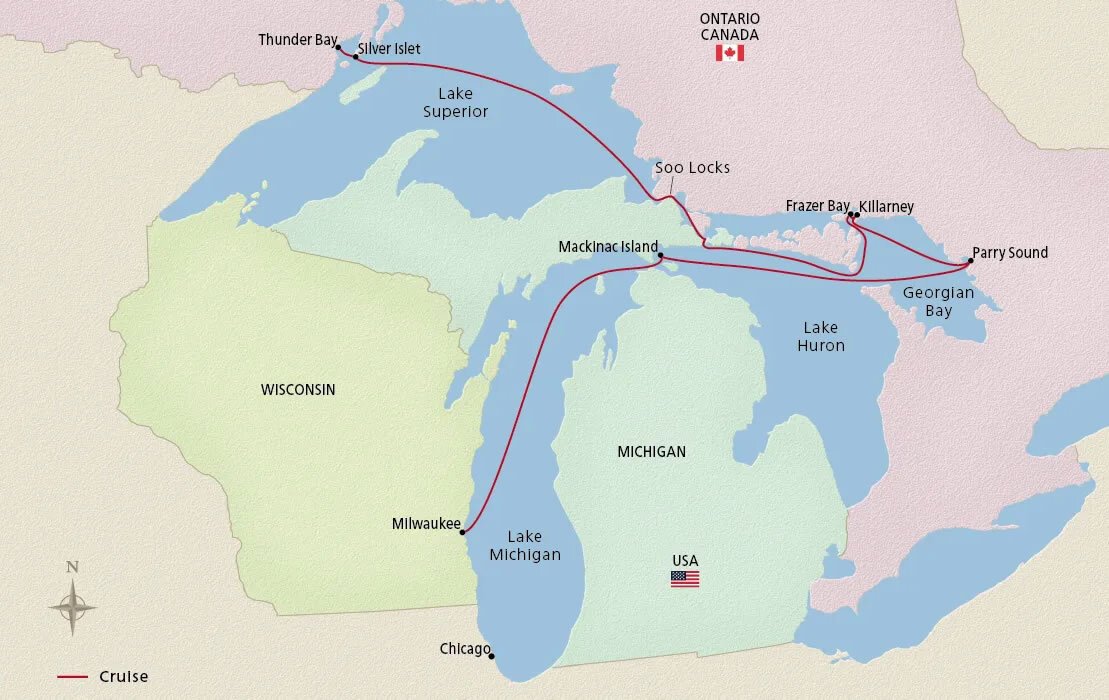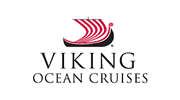Overview
Itinerary
Embark your ship and settle into your stateroom. Milwaukee was first settled by Europeans in 1818, when French-Canadian fur trader Solomon Juneau arrived. German, Polish and Eastern European immigrants followed, bringing with them a long tradition of beer brewing. For several decades in the 20th century, Milwaukee became the world's most prolific beer producer. Today, the city is a vibrant center of art, history and culture. The RiverWalk, a pedestrian walkway along the Milwaukee, is a popular spot for enjoying relaxing strolls or viewing public art installations.
Steeped in the charms of simpler times, Mackinac Island is a gem of the Great Lakes. Located in the Straits of Mackinac where Michigan's upper and lower peninsulas are closest and Lakes Huron and Michigan meet, this bucolic haven preserves gilded Victorian-era treasures along car-free streets traversed by horse-drawn carriages. The perimeter road is the only state highway in the US that does not permit motor vehicles. More than 80% of Mackinac is protected as a state park, from its Greek Revival Grand Hotel and British-built Fort Mackinac to its preserved wilderness areas.
Parry Sound boasts the world's deepest natural freshwater port. The town was established at the mouth of the Seguin River in 1857 near the Ojibwe village known as Wasauksing, or 'shining shore.' The arrival of the railroad during the late-19th century gave Parry Sound new importance as a stop on the transcontinental Canadian Pacific line. For art lovers, nearby Algonquin Provincial Park is best known for its majestic wilderness, captured on canvas by the Group of Seven, a cadre of early 20th-century Canadian landscape painters inspired by their country's natural world.
Killarney was founded by a French-Canadian fur trader in 1820; he named the post Shebahonaning, or 'canoe passage.' Its location on the northern shore of Georgian Bay made it ideal for trading. Nearby, the stunning cliffs of the La Cloche range rise dramatically above the shores of Lake Huron. These remarkable mountains are the pinnacle of Killarney Provincial Park, a vast wilderness of lakes and Eastern mixed forest. This breathtaking expanse of protected land is laced with hiking trails and—true to Killarney's original name—canoe routes that link the area's lake system.
Frazer Bay is located off a remote finger of land on the eastern tip of the North Channel in Ontario's Georgian Bay, a UNESCO Biosphere Reserve. Its eponymous hill reaches almost 600 feet, offering sweeping views of the surrounding landscape. The bay lies near Killarney Provincial Park, a vast wilderness of lakes and Eastern mixed forest framed by glacier-sculpted pink granite cliffs. Across the channel lies scenic Manitoulin Island, the world's largest freshwater lake island and itself home to another 108 freshwater lakes—some with islands of their own.
The Soo Locks is a series of parallel locks that make river travel between Lake Superior and Lake Huron possible, thereby linking Superior to the lower Great Lakes and the Atlantic. Opened in 1855 to allow ships to bypass the river's 21-foot fall over roiling rapids, this innovative lock system—along with the Erie Canal built 30 years prior—was one of the great engineering projects of its day. Today, it guides ships past the twin cities of Sault Ste. Marie in Ontario and Sault Ste. Marie in Michigan; its bridge crosses over the Soo Locks, connecting the two cities.
Silver Islet sits on the southern edge of the Sibley Peninsula at the mouth of Thunder Bay. Nearby Sleeping Giant Provincial Park attracts outdoor enthusiasts year-round with its diverse wildlife and many miles of hiking trails that lead to spectacular views of the Canadian Shield landscape. Less than a mile from its shores are the remnants of an abandoned silver mine. Located 1,200 feet below Lake Superior, this unique underwater mine was the world's largest and most valuable silver mine, producing the modern-day equivalent of $78 million before flooding in 1884.
Thunder Bay is known as “Canada's Gateway to the West” for its location at the final navigational point on the Canadian side of Lake Superior. Originally founded as a fur trading post, a settlement was established in 1803 and Fort William was erected. In 1970, Fort William and neighboring Port Arthur were merged to form the City of Thunder Bay. Today, it is one of Ontario's most vibrant cities and a center of art and culture. Its Waterfront District is beloved for its views across the bay of the Sleeping Giant, a long line of mesas that resemble a giant lying on its back. Transfer to your ship and settle into your stateroom.
Life Onboard Viking Octantis

Launching in 2022, the Viking Octantis is Vikings' newest expedition ship, part of a fleet of award winning, state of the art ships built for exploration in sensitive environments. Read more

Viking are destination experts. With no casinos or children on board, you can be assured that the focus is firmly on enrichment and education. Read more

After a day of exploration or just to enhance the relaxation of a day at sea, the on-board Spa will leave you feeling recharged and revitalized. Read more

Viking offer six on board dining options. Beer, wine and soft drinks are available with lunch and dinner at no additional charge of fee. Read more

Viking proudly includes all that you need and nothing you do not. A variety of features and services are standard inclusions on your cruise. Read more

Viking include one complimentary shore excursion in every port of call. Enjoy included experiences around the world. Read more

Brochure

Viking River, Ocean & Expedition Voyages (2025-27)
Availability
 USD
Port charges, taxes and fees included.
USD
Port charges, taxes and fees included.
Tour & cruises prices are per person. Prices shown have savings applied, are subject to availability and may be withdrawn at any time without notice. Pricing and trip details are correct at this point in time, however are subject to confirmation at the time of booking and are subject to change by Viking. For cruise itineraries, cabin images are sourced from Viking. These should be treated as indicative only. Cabin inclusions, upholsteries and room layout may differ to the image(s) shown depending on the ship selected and your sailing dates.









